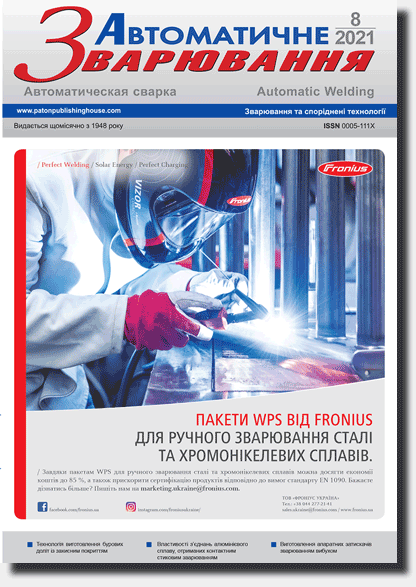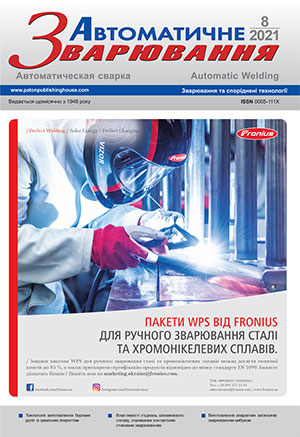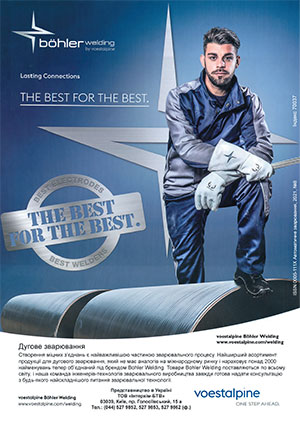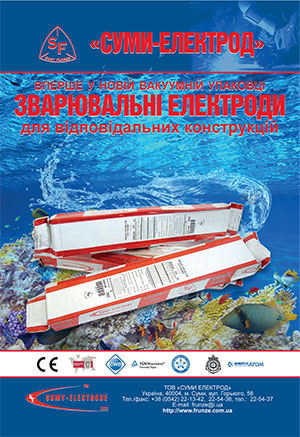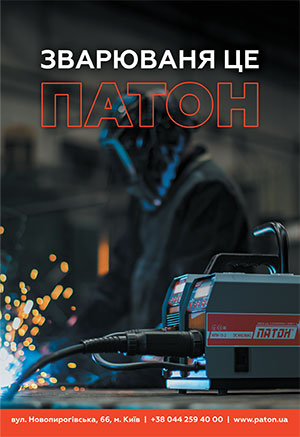| 2021 №08 (05) |
DOI of Article 10.37434/as2021.08.06 |
2021 №08 (07) |
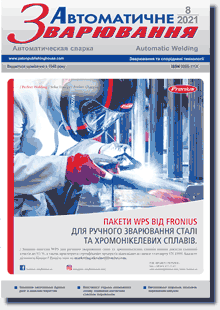
"Avtomatychne Zvaryuvannya" (Automatic Welding), #8, 2021, pp. 29-34
Numerical modelling of stress-strain state of elements
І.K. Senchenkov1, М.V. Iurzhenko2, О.P. Chervinkо1, О.P. Masiuchok2, M.G. Korab2
1S.P. Timoshenko Institute of Mechanics of NAS of Ukraine, 3 Nesterov Str., 02000, Kyiv, Ukraine
2E.O. Paton Electric Welding Institute of the NAS of Ukraine, 11 Kazymyr Malevych Str., 03150, Kyiv, Ukraine. E-mail: office@paton.kyiv.ua
Manufacture of parts by the method of 3D printing, in particular, applying FDM (Fusing Deposition Modeling) technology, is a promising trend in many branches of mechanical engineering, architecture, construction, medicine, etc. This range of problems challenges three main directions of studies: FDM 3D printing technology, materials science and mathematical modeling of processes for evaluation of functional qualities, in particular, strength of products. This work is devoted to the third direction: evaluation of stress-strain state of products manufactured by 3D printing using FDM technology. The paper considers three stages of solving this problem: 1 – mathematical formulation of the problem, which includes universal balance relations, determining equations of mechanical behaviour of the material; 2 – method of numerical solution of the problem; 3 – solving specific problems in order to determine patterns of thermomechanical processes and provide recommendations for technological parameters of 3D printing. 10 Ref., 12 Fig.
Keywords: additive technology, FDM 3D printing, mathematical modeling, stress-strain stateології, FDM 3D друк, математичне моделювання, напружено-деформований стан
Received: 11.06.2021
References
1. (2016) Additive Manufacturing and 3D Printing State of the Industry Annual Worldwide Progress Report. Wohler`s Associates, Inc.2. Masiuchok, O.P., Yurzhenko, M.V., Kolisnyk, R.V., Korab, M.H. (2020) Adytyvni tekhnolohii polimernykh materialiv (Ohliad). Avtomatychne zvariuvannia, 5, 53-60. https://doi.org/10.37434/as2020.05.08
3. Turner, B.N., Strong, R., Gold, S.A. (2014) A review of melt extrusion additive manufacturing processes: I. Process design and modeling. Rapid Prototyping Journal, 20, 3, 192-204. https://doi.org/10.1108/RPJ-01-2013-0012
4. Wong, K., Hernandez, A. (2012) A Review of Additive Manufacturing, International Scholarly Research Network (ISRN). Mechanical Engineering. https://doi.org/10.5402/2012/208760
5. 3D-pechat` dlya «chajnikov» ili «chto takoe 3D-printer»? [Elektronnij resurs]. Rezhim dostupu: http://3dtoday.ru/ wiki/3dprint_basics/. [in Russian].
6. Sapronov, O.O., Buketov, A.V., Marushchak, P.O. et al. (2019) Research of crack initiation and propagation under loading for providing impact resilience of protective coating. Functional materials., 26(1). 114-120. https://doi.org/10.15407/fm26.01.114
7. Arutyunyan, N.Kh., Drozdov, A.D., Naumov, V.E. (1987) Mekhanika rastushhikh vyazkouprugoplasticheskikh tel., Moskow, Nauka.
8. Senchenkov, I.K. (2005) Termomekhanicheskaya model` rastushhikh czilindricheskikh tel iz fizicheski nelinejny`kh materialov. Prikl. Mekhanika, 41, 9, 118-126.
9. Motovilovecz, I.A., Kozlov, I.I., (1987) Mekhanika svyazanny`kh polej v materialakh i elementakh konstrukczij v 5-ti t. T.1. Termouprugost`. Kiev, Naukova Dumka.
10. Battegazzore, D., Bocchini, S., Frache, A. (2011) Crystallization kinetics of poly(lactic acid)-talc composites. eXPRESS Polymer Letters, 5, 10, 849-858. https://doi.org/10.3144/expresspolymlett.2011.84
Advertising in this issue:
The cost of subscription/purchase order journals or individual articles
| Journal/Currency | Annual Set | 1 issue printed |
1 issue |
one article |
| TPWJ/USD | 384 $ | 32 $ | 26 $ | 13 $ |
| TPWJ/EUR | 348 € | 29 € | 24 € | 12 € |
| TPWJ/UAH | 7200 UAH | 600 UAH | 600 UAH | 280 UAH |
| AS/UAH | 1800 UAH | 300 UAH | 300 UAH | 150 UAH |
| AS/USD | 192 $ | 32 $ | 26 $ | 13 $ |
| AS/EUR | 180 € | 30 € | 25 € | 12 € |
| SEM/UAH | 1200 UAH | 300 UAH | 300 UAH | 150 UAH |
| SEM/USD | 128 $ | 32 $ | 26 $ | 13 $ |
| SEM/EUR | 120 € | 30 € | 25 € | 12 € |
| TDNK/UAH | 1200 UAH | 300 UAH | 300 UAH | 150 UAH |
| TDNK/USD | 128 $ | 32 $ | 26 $ | 13 $ |
| TDNK/EUR | 120 € | 30 € | 25 € | 15 € |
AS = «Automatic Welding» - 6 issues per year;
TPWJ = «PATON WELDING JOURNAL» - 12 issues per year;
SEM = «Electrometallurgy Today» - 4 issues per year;
TDNK = «Technical Diagnostics and Non-Destructive Testing» - 4 issues per year.





